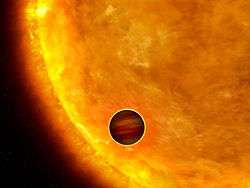COROT-1
| Observation data Epoch J2000.0 Equinox J2000.0 | |
|---|---|
| Constellation | Monoceros |
| Right ascension | 06h 48m 19.172s[1] |
| Declination | −03° 06′ 07.68″[1] |
| Apparent magnitude (V) | 13.6[1] |
| Characteristics | |
| Spectral type | G0V[1] |
| Apparent magnitude (V) | ~13.6[1] |
| Apparent magnitude (I) | 12.88 ±0.04[1] |
| Apparent magnitude (J) | 12.462 ±0.029[1] |
| Apparent magnitude (H) | 12.218 ±0.026[1] |
| Apparent magnitude (K) | 12.149 ±0.027[1] |
| Variable type | Pulsating variable[2] |
| Astrometry | |
| Proper motion (μ) | RA: -9.6[1] mas/yr Dec.: 6.2[1] mas/yr |
| Distance | 1,560 ly (480 pc) |
| Details | |
| Mass | 0.95 ±0.15 M☉ |
| Temperature | 5950 ±150 K |
| Metallicity | -0.3 ±0.25 |
| Age | ? years |
| Other designations | |
| Database references | |
| SIMBAD | data |
| Extrasolar Planets Encyclopaedia | data |
COROT-1 is a yellow dwarf main sequence star similar to our Sun. The star is located approximately 1,560 light-years away in the constellation of Monoceros. The apparent magnitude of this star is 13.6, which means it is not visible to the naked eye; however, it can be seen through a medium-sized amateur telescope on a clear, dark night.[1] The first exoplanet discovered in the course of the COROT mission orbits this star; it is considered to be a "hot Jupiter," and is approximately as massive as the planet Jupiter itself.
Nomenclature
The designation "COROT" is a result of its observation by the French-directed Convection, Rotation, and Planetary Transits mission, which was launched late December 2006 with one goal involving the search for exoplanets by measuring the varying brightness of candidate stars when transited by any present exoplanets;[3] CoRoT's second goal pertains to the study of the interiors of stars, which is done by analyzing the characteristics and behavior of light released from the star.[4] The numerical designation was assigned because the first exoplanet discovered by the CoRoT telescope was found in orbit of this star.[5] COROT-1 does not have a common or colloquial name like that of Sirius or Procyon.
Characteristics
COROT-1 is a G-type star, meaning the light it emits is similar to that of the Sun's. Likewise, the star is of nearly the same temperature and mass of the Sun.[1] At an apparent magnitude of approximately +13.6,[1] doubly dimmer than the dimmest star visible with the naked eye, COROT-1 cannot be seen from Earth without magnification apparatus.[6]
Variability
When COROT-1 was observed by the CoRoT telescope over a continuous period of sixty days since the preliminary results release on 23 May 2007, the star's light exhibited patterns identical to pulsating variable stars with characteristics similar to that of the Sun.[2]
Planetary system

This star is home to the transiting exoplanet CoRot-1b, the first exoplanet discovered by the CoRoT Mission spacecraft.[7] The planet, which is similar to that of the planet Jupiter's in terms of mass, orbits approximately .02 AU away from its parent star.[4] In comparison, the planet Mercury orbits at approximately .387 AU from the Sun.[8] COROT-1b is presumed to be tidally locked to its star.[9]
The planet was the first to be sighted optically rather than through infrared.[10] Unlike other "hot Jupiters," this occurrence seems to imply that the heat transfer between the hemisphere of the planet facing the star and the hemisphere facing away is not significant.[9]
| Companion (in order from star) |
Mass | Semimajor axis (AU) |
Orbital period (days) |
Eccentricity | Inclination | Radius |
|---|---|---|---|---|---|---|
| b | 1.03 ±0.12 MJ | 0.0254 ±0.0004 | 1.5089557 ±6.4e-06 | 0 | 85.1 ± 0.5° | 1.49±0.08 RJ RJ |
See also
References
- 1 2 3 4 5 6 7 8 9 10 11 12 13 14 15 "SIMBAD query result: GSC 04804-02268 -- Star". Centre de Données astronomiques de Strasbourg. Retrieved 2009-04-27.
- 1 2 "Success of the First CoRoT Satellite Observation: First Exoplanet and First Stellar Oscillations" (PDF). Centre National d'Études Spatiales. Centre National de la Recherche Scientifique. 23 May 2007. Retrieved 2009-05-30.
- ↑ "COROT Home Page". Convection, Rotation, and Planetary Transits Mission. Centre National D'Études Spaciales (CNES). 2009. Retrieved 2009-05-29.
- 1 2 "COROT discovers its first exoplanet and catches scientists by surprise". European Space Agency. European Space Agency. 3 May 2007. Retrieved 2009-05-29.
- ↑ "Corot detecta un nuevo planeta más grande que Júpiter". PortalCiencia: Noticias en Astronomía (in Spanish). PortalCiencia.com. 2007. Retrieved 2009-05-29.
- ↑ "Stellar Magnitudes". Astrophysics 162 Unit. University of Tennessee. 2008. Retrieved 28 May 2009.
- ↑ Barge, P.; Baglin, A.; Auvergne, M.; Rauer, H.; Léger, A.; Schneider, J.; Pont, F.; Aigrain, S.; Almenara, J. -M.; Alonso, R.; Barbieri, M.; Bordé, P.; Bouchy, F.; Deeg, H. J.; La Reza, D.; Deleuil, M.; Dvorak, R.; Erikson, A.; Fridlund, M.; Gillon, M.; Gondoin, P.; Guillot, T.; Hatzes, A.; Hebrard, G.; Jorda, L.; Kabath, P.; Lammer, H.; Llebaria, A.; Loeillet, B.; et al. (2008). "Transiting exoplanets from the CoRoT space mission". Astronomy and Astrophysics. 482 (3): L17. arXiv:0803.3202
 . Bibcode:2008A&A...482L..17B. doi:10.1051/0004-6361:200809353.
. Bibcode:2008A&A...482L..17B. doi:10.1051/0004-6361:200809353. - ↑ "Mercury Statistics". Windows to the Universe program. University Corporation for Atmospheric Research (UCAR). 2003. Retrieved 2009-05-29.
- 1 2 Andrea Thompson (2009-05-27). "Exoplanet Phases Seen in Optical Light". Space.com. Retrieved 2009-05-29.
- ↑ Ignas A. G. Snellen; Ernst J. W. de Mooij; Simon Albrecht (2009-05-29). "The changing phases of extrasolar planet CoRoT-1b". Nature. 459 (7246): 543–545. arXiv:0904.1208
 . Bibcode:2009Natur.459..543S. doi:10.1038/nature08045. PMID 19478779.
. Bibcode:2009Natur.459..543S. doi:10.1038/nature08045. PMID 19478779.
External links
- "CoRot-1". Exoplanets. Retrieved 2009-04-28.
Coordinates: ![]() 06h 48m 19.17s, −03° 06′ 07.68″
06h 48m 19.17s, −03° 06′ 07.68″
